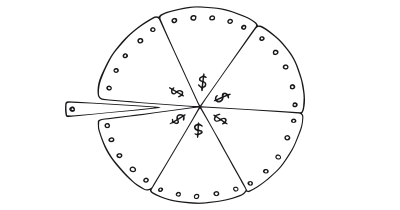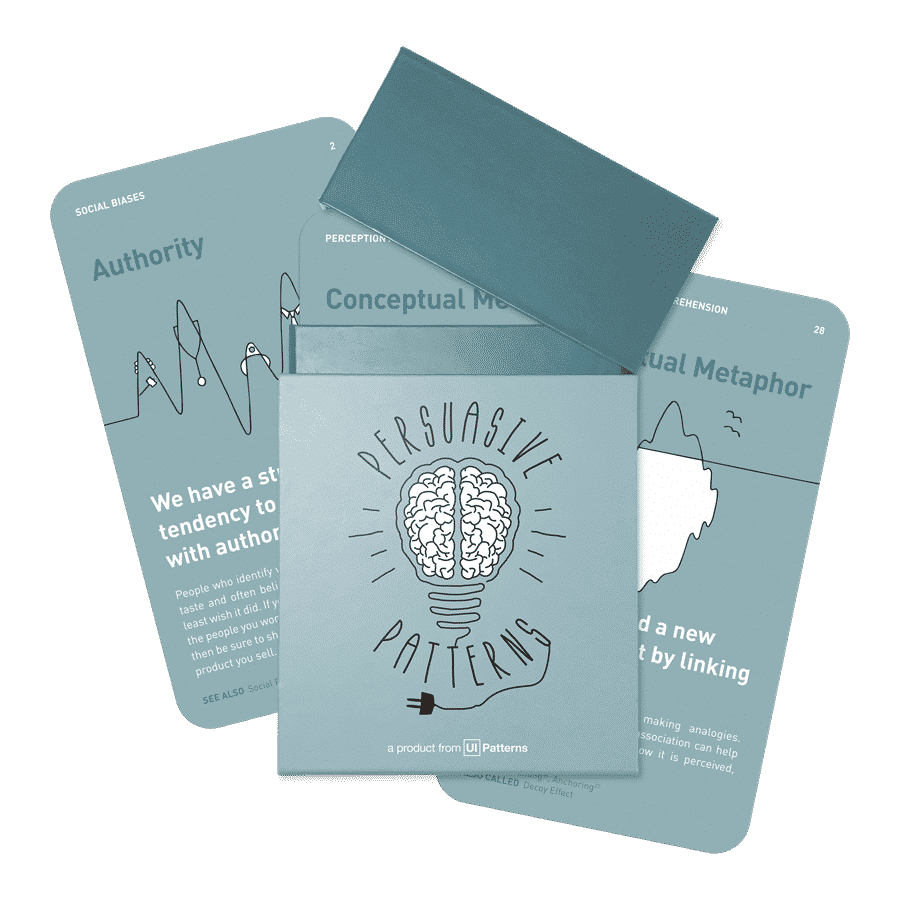Cognitive Bias
Also called: Hyperbolic Discounting
This persuasive pattern is part of the Persuasive Patterns printed card deck.
The Persuasive Patterns Card Deck is a collection of 60 design patterns driven by psychology, presented in a manner easily referenced and used as a brainstorming tool.
Get your deck!Delay discounting is a psychological phenomenon observed in decision-making processes where individuals show a preference for immediate gratification, often at the expense of long-term benefits. This pattern is crucial in understanding consumer behavior, especially in scenarios involving financial decisions, health-related choices, and any context requiring delayed gratification.
Imagine you’re cleaning your apartment (a not-so-thrilling task for many). You come across a $20 bill hidden under the couch cushions – a pleasant surprise! Now you face a choice: cash in the $20 now and treat yourself to a delicious lunch, or hold onto it and use it towards a larger purchase you’ve been saving for. The immediate gratification of lunch might be tempting, even though the larger purchase might bring more long-term satisfaction. This internal struggle highlights the influence of delay discounting – our tendency to value immediate rewards more than larger rewards that are delayed.
This tendency translates directly to the digital world. Consider a popular fitness app. The app offers two reward options for completing daily workout challenges. One option is 50 points immediately after each workout. The other option is 100 points, but you only receive them after a week of consistent workouts. Research suggests that many users, influenced by delay discounting, might opt for the smaller, immediate reward, even though the larger reward offers a greater long-term benefit for their fitness goals.
The marshmallow experiment
Imagine a young child faced with a tempting choice: enjoy a single marshmallow right now, or wait a short while and be rewarded with two marshmallows. This seemingly simple scenario lies at the heart of the famous Marshmallow Experiment, conducted by psychologist Walter Mischel in the early 1970s. The study explored children’s ability to delay gratification, a key concept in understanding delay discounting.
The results were captivating. Researchers found that roughly one-third of the children were able to resist the immediate temptation and wait for the larger reward. This seemingly small percentage highlights the powerful influence of delay discounting – our tendency to value a smaller reward received sooner more than a larger reward that is delayed.
Mischel, W., Ebbesen, E. B., & Zeiss, A. R. (1972). Self-control and socialization in a nursery school setting. Journal of Personality and Social Psychology, 21(2), 265–270.
The psychological principle underlying the pattern of Delay Discounting is primarily based on the concept of hyperbolic discounting, a model within behavioral economics that describes how humans and other animals devalue rewards and benefits based on the delay to their receipt. This principle posits that individuals prefer rewards that arrive sooner rather than later, even if the delayed reward is significantly greater.
The tendency to choose immediate over delayed gratification is influenced by the limbic system in the brain, which processes emotions and rewards. This system often overpowers the more rational, future-oriented planning carried out by the prefrontal cortex. The immediacy of a reward triggers a stronger emotional response than a promise of a future benefit, leading to decision-making that often disregards long-term benefits in favor of immediate satisfaction.
Neuroscientific studies indicate that delay discounting involves several brain areas, including the prefrontal cortex, which is responsible for impulse control and decision-making, and the ventral striatum, which is involved in reward anticipation. When the immediacy of a reward is perceived, it often results in an enhanced activation of these neural pathways, overshadowing the cognitive processes that evaluate the future consequences of current actions.
This psychological mechanism can be explained through evolutionary psychology, suggesting that in environments where the future was uncertain, prioritizing immediate rewards could have survival benefits. However, in modern contexts, this can lead to less optimal decisions, such as financial imprudence or unhealthy lifestyle choices.
Delay Discounting is also influenced by the Present Bias – our tendency to value rewards we can receive immediately more than those that are delayed, even if the delayed reward is objectively larger. This can be explained by the concept of present focus. Our brains prioritize experiences happening now and tend to downplay the significance of future events. Imagine receiving a $10 bill today versus knowing you’ll get $20 next week – the immediate gratification of the $10 often feels more appealing.
Understanding the interplay between these emotional and cognitive processes is crucial for designing interventions or systems that can help modify or mitigate the effects of delay discounting in decision-making scenarios. By leveraging this understanding, designers and strategists can craft effective motivational strategies that encourage individuals to opt for choices that are beneficial in the long term.
Designing products about Delay Discounting
Delay discounting presents a challenge for designers – how do we encourage users to make choices that benefit them in the long run, even when immediate gratification beckons?
To accommodate this trend, try to frame delayed rewards in a way that underlines their future benefits. By visualizing progress towards a long-term goal or illustrating the positive impact of delayed gratification, users can perceive the value of waiting. For instance, a budgeting app might project future financial gains from consistent savings, making the abstract concept of financial security more tangible and immediate.
Breaking down substantial, long-term rewards into smaller, more manageable milestones can mitigate the overwhelming nature of distant goals. This approach not only maintains motivation but also provides frequent, tangible proof of progress. A fitness app, for example, could segment a weight loss goal into weekly mini-challenges, each with its own set of rewards, thus maintaining engagement through a sense of continual achievement.
Use pre-commitment strategies. Encouraging users to commit in advance to long-term goals helps bridge the gap between immediate desires and future benefits. By offering incentives like discounted rates for committing to a period of usage, apps can lock in user engagement. A language learning platform might reduce subscription costs for users who commit to a six-month learning program, leveraging the commitment to foster consistent usage.
Focusing too heavily on immediate rewards can undermine long-term user engagement and retention. Users may lose interest once the initial rewards have been claimed.
To prevent short-term distractions from derailing long-term objectives, it’s effective to reduce the salience of immediate but counterproductive rewards. An e-commerce site, for example, could design checkout processes that minimize impulse buys, focusing users on completing planned purchases, thereby supporting more deliberate decision-making.
Tap into Loss Aversion. Framing potential future benefits as losses if not acted upon can powerfully motivate users. Highlighting what might be missed if actions aren’t taken taps into the user’s aversion to loss. Travel apps effectively use this strategy by showing how delaying booking might lead to higher prices or missing out on limited deals.
Offering immediate rewards for actions taken shortly after engagement begins can significantly boost initial user interest. For example, a mobile app providing immediate bonuses for user registration or the completion of an introductory tutorial can effectively capitalize on the user’s preference for immediate rewards.
Offering rewards that don’t align well with the effort required or the user’s goals can lead to dissatisfaction and reduced motivation.
Tailoring rewards to fit individual preferences and behaviors can make delayed gratifications feel more relevant and personal, thereby increasing their perceived value. Personalization ensures that the rewards resonate more strongly with the user, making the wait more acceptable and even desirable.
It’s beneficial to continuously monitor user engagement and adapt reward schedules to maintain or rekindle interest. Providing unexpected rewards or adjusting challenges according to user activity can keep the experience fresh and responsive to user needs.
Don’t eliminate the appeal of immediate rewards entirely. Strive for a balance that motivates users towards long-term benefits.
Ethical recommendations
Delay discounting, while a powerful tool, requires careful consideration to avoid ethical pitfalls. Unethical use can exploit users’ vulnerabilities or prioritize immediate gain over genuine user benefit.
Delay discounting can be misused to create a sense of urgency and pressure users into impulsive decisions. For instance, an e-commerce platform might display fake countdown timers or limited-time offers to nudge users into making quick purchases without careful consideration (exploiting present bias).
Misleading users about the true value of immediate rewards can be unethical. For example, a mobile game might advertise a seemingly small in-app purchase to unlock a crucial feature, but neglect to disclose the recurring costs associated with maintaining that feature (manipulating perception of value).
Delay discounting can be used to target users with vulnerabilities, such as those struggling financially or with impulse control. This could involve promoting instant gratification through quick loan options or subscription services with complex cancellation procedures (taking advantage of short-sighted decision-making).
To ensure that the application of delay discounting remains ethical and user-centric, designers and marketers should adhere to the following best practices:
- Be transparent
Clearly communicate the long-term consequences of choices. Users should be fully aware of what they are foregoing by choosing immediate rewards. This includes transparently displaying the cost-benefit analysis of such decisions. Avoid deceptive tactics regarding immediate rewards. - Balance immediate and long-term rewards
While leveraging the appeal of immediate rewards, it is crucial to balance these with the long-term benefits. Ensure that users are not misled into actions that they might regret, which can undermine trust and loyalty. Prioritize strategies that genuinely benefit users in the long term. Highlight how smaller, immediate rewards contribute to achieving larger goals. - Protect vulnerable users
Implement safeguards to protect vulnerable groups, particularly in environments prone to addictive behaviors. This could include setting limits on the frequency of rewards or offering tools to help users manage their engagement. - Encourage reflective decision-making
Design systems that encourage users to reflect on their choices by occasionally prompting them to consider the long-term implications of their immediate decisions. This could be achieved through reminders or decision aids that highlight the future benefits of different options. Empower users to make informed decisions. Provide clear information and avoid manipulative pressure tactics that exploit delay discounting. - Nudge, don’t force
Subtly nudge users towards long-term benefits without taking away their agency. Offer choices and allow users to make well-considered decisions based on the presented information. While it’s beneficial to engage users, it should not come at the cost of exploiting their cognitive biases. Rewards should be aligned with genuinely beneficial behaviors rather than merely driving compulsive usage.
Examples
Amazon Prime
Amazon offers immediate benefits like free two-day shipping for Prime members, which encourages shoppers to sign up for the service for an immediate reward, despite the annual membership fee. This has significantly increased customer loyalty and purchase frequency due to the allure of immediate gratification from fast shipping.
Dropbox
Dropbox offers immediate extra storage space for users who complete certain tasks like referring a friend or setting up the photo upload feature. This strategy effectively converts new users into active promoters of the service, leveraging immediate rewards to enhance user engagement and expand their customer base.
Duolingo
Duolingo offers immediate rewards like in-app currency and unlockable content for completing language lessons, which makes the learning process more engaging. This approach helps maintain high user engagement rates by providing small, immediate rewards that keep users coming back for more lessons over time.
Trigger Questions
- What long-term benefits does our product offer users?
- How can we visualize progress towards those long-term goals?
- Can we break down large rewards into smaller, more achievable milestones?
- Are there ways to pre-commit users to choices that benefit them in the long run?
- How can we minimize the immediate allure of less beneficial options?
- Can we leverage loss aversion to frame delayed gratification as avoiding a missed opportunity?
- How do we balance immediate and delayed rewards to maximize both engagement and long-term value?
- How can we ensure that the rewards system does not overshadow the intrinsic value of the product or service?
- What strategies can we implement to keep users engaged even after they have claimed the most easily accessible rewards?
Pairings
Delay Discounting + Rewards + Achievements
Pairing Delay Discounting with the Rewards pattern can enhance its effectiveness. By offering immediate small rewards for actions that contribute to long-term goals, users are more likely to engage in behaviors that benefit them in the future. For example, a fitness app might provide small, immediate rewards for each workout completed, which contributes to a larger goal of health improvement.

We tend to choose smaller immediate rewards over larger, later rewards

Use rewards to encourage continuation of wanted behavior

We are engaged by activities in which meaningful achievements are recognized
Delay Discounting + Goal-Gradient Effect
This pattern, which states that people’s efforts increase as they approach a goal, complements Delay Discounting by breaking down a long-term goal into smaller, more immediate steps that seem more achievable and immediately rewarding.

We tend to choose smaller immediate rewards over larger, later rewards

Our motivation increases as we move closer to a goal
Delay Discounting + Endowed Progress Effect
This effect creates a perception of progress towards a goal by providing an artificial advancement at the beginning of the process. When used with Delay Discounting, it can motivate users to start working towards a long-term goal by reducing the perceived distance to the goal.

We tend to choose smaller immediate rewards over larger, later rewards

Early help speeds up goal achievement
Delay Discounting + Framing Effect
How choices are presented can influence decision outcomes. By framing the long-term benefits of a choice as more immediate through clever messaging, users can be encouraged to make decisions that favor long-term rewards.

We tend to choose smaller immediate rewards over larger, later rewards

The way a fact is presented greatly alters our judgment and decisions
Delay Discounting + Loss Aversion
Many mobile games offer in-app purchases to unlock features or progress faster. This leverages delay discounting (immediate purchase for faster progress). However, the game might also utilize Loss Aversion by highlighting the limitations or disadvantages of playing without the purchased features. This emphasizes the potential loss of enjoyment (aversion to missing out) if the user doesn’t make the purchase, nudging them towards the immediate gratification of a more enjoyable gameplay experience (delayed reward in the form of continued engagement).

We tend to choose smaller immediate rewards over larger, later rewards

Our fear of losing motivates us more than the prospect of gaining
Delay Discounting + Commitment & Consistency
Subscription services like Netflix often employ a Commitment & Consistency pattern by offering free trial periods. This allows users to experience the platform’s value (delayed reward) before committing to a paid subscription. However, Netflix might also leverage delay discounting by offering a discounted subscription rate for users who pre-commit to a longer subscription term upfront. This combination encourages users to prioritize the long-term benefit (discounted price) by leveraging the initial appeal of a lower upfront cost.

We tend to choose smaller immediate rewards over larger, later rewards

We want to appear consistent with our stated beliefs and prior actions
Delay Discounting + Scarcity Bias
Many e-commerce platforms (e.g., Booking.com) utilize Scarcity Bias by highlighting limited-availability discounts or displaying the number of remaining items in stock. This creates a sense of urgency and potential loss (aversion to missing out), nudging users towards a purchase decision. However, the platform might also showcase the long-term benefits of the purchase (e.g., high-quality product with a long lifespan). This combination addresses both delay discounting (immediate purchase decision) and the value of the delayed reward (durable product).

We tend to choose smaller immediate rewards over larger, later rewards

We value something more when it is in short supply
Delay Discounting + Framing Effect
Financial planning apps often leverage the Framing Effect to present saving goals in a positive light. For example, framing saving for retirement as “securing your dream vacation lifestyle” emphasizes the future benefit (delayed reward). This approach can be enhanced by incorporating delay discounting strategies. The app might showcase a progress bar visualizing how much closer the user gets to their dream vacation with each deposit (smaller, immediate rewards contribute to long-term goal).

We tend to choose smaller immediate rewards over larger, later rewards

The way a fact is presented greatly alters our judgment and decisions
Delay Discounting + Social Proof
Fitness trackers often integrate Social Proof by allowing users to share their workout achievements with friends. This fosters a sense of community and motivates users to maintain their exercise routines (delayed reward of improved fitness). The tracker might further leverage delay discounting by offering badges or virtual rewards for completing daily workouts (smaller, immediate rewards that contribute to long-term goals and social recognition).

We tend to choose smaller immediate rewards over larger, later rewards

We assume the actions of others in new or unfamiliar situations
This persuasive pattern is part of the Persuasive Patterns printed card deck.
The Persuasive Patterns Card Deck is a collection of 60 design patterns driven by psychology, presented in a manner easily referenced and used as a brainstorming tool.
Get your deck!- Judgment and decision making: psychological perspectives by Hardman
- Hyperbolic Discounting
- Ainslie, G. (1975). Specious reward: a behavioral theory of impulsiveness and impulse control. Psychological Bulletin, 82(4), 463-496.
- Mazur, J.E. (1987). An adjusting procedure for studying delayed reinforcement. In Quantitative analyses of behavior: Vol. 5. The effect of delay and intervening events on reinforcement value (pp. 55-73). Hillsdale, NJ: Erlbaum.
- Green, L., & Myerson, J. (1996). Exponential versus hyperbolic discounting of delayed outcomes: Risk and waiting time. American Zoologist, 36(4), 496-505.
- Kirby, K.N., & Herrnstein, R.J. (1995). Preference reversals due to myopic discounting of delayed reward. Psychological Science, 6(2), 83-89.
- Laibowitz, D. T. (1978). Negative discounting of delayed rewards: Experimental analysis of a real-life phenomenon. Organizational Behavior and Human Performance, 21(1), 1–10.
- Frederick, S., Loewenstein, G., & O'Donoghue, T. (2002). Time discounting and time preference: A critical review. Journal of Economic Literature, 40(2), 351–401.
- Mischel, W., Ebbesen, E. B., & Zeiss, A. R. (1972). Self-control and socialization in a nursery school setting. Journal of Personality and Social Psychology, 21(2), 265–270.
- Loewenstein, G., & Lerner, J. S. (2003). The role of affect in decision making. In R. J. Davidson, H. Goldsmith, & K. R. Scherer (Eds.), Handbook of affective sciences (pp. 619-642). Oxford University Press.
- Bechara, A., Damasio, A. R., Damasio, H., & Anderson, S. W. (1994). Insensitivity to future consequences following damage to human prefrontal cortex. Cognition, 50(1-3), 7-15.
- Coker, Kesha & Pillai, Deepa & Balasubramanian, Siva. (2010). Delay-discounting rewards from consumer sales promotions. Journal of Product & Brand Management. 19. 487-495.
